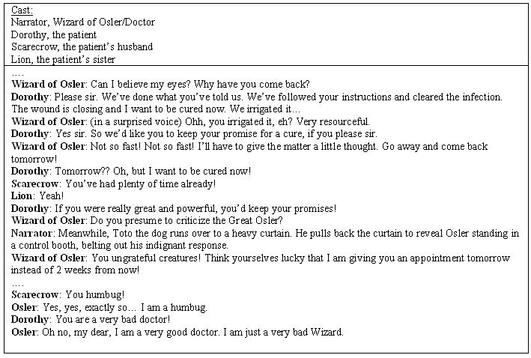Empathy is one of the most important medical practice skills. Medical theater, a combination of medical simulation, role-playing, and improvisation, is a teaching method that educators are testing to improve the empathy skills of medical students and medical residents. Medical Theater is similar to the psychodrama technique used as method of group therapy to help patients improve and learn skills for physical and emotional well-being. The common idea between the two methods is the understanding of another’s feelings and emotions by acting them out. Headspace Theater is an example of the medical theater method.
Headspace Theater (Ballon, Silver, & Fidler, 2007) targets mental health and addiction issues. It allows small medical groups to learn about psychiatric conditions using techniques based on improvisational theater, role-playing games, and live-action role playing. A Headspace Theater lesson plan includes at least 10 minutes of both “actor mode,” role playing within a scenario, and debriefing mode, discussing the situation from the viewpoints of the protagonist, other players, and audience members. For example, in an alcohol use disorder scenario, a protagonist with no memory of the previous night, is experiencing a hangover; he is in the shower with a stranger and has police are knocking on his front door.
Similar to the Headspace Theater scenario is the Fetters medical theater adaptation of The Wizard of Oz (see Figure 1) (Fetters, 2006). The Oz characters become patients, family members, and doctors. The questions below the figure are examples of the debriefing questions that follow the exercise.
Figure 1: The Wizard of Osler: An excerpt and sample questions from The Wizard of Osler: A Brief Educational Intervention Combining Film and Medical Readers’ Theater to Teach About Power in Medicine (Fetters, 2006)
Sample Questions:
1. How does the Wizard of Osler resemble any doctors you have known or know?
2. How does Dorothy’s circumstance resemble the situation of a patient?
5. Do you see anything in the relationship between Oz and Dorothy that may resemble relationships between the doctor and patient?
6. What analogies do you see between Dorothy’s desire to go home and the image of illness taking the patient on a journey?
7. How is Osler the Wizard different from Osler the Doctor?
Discussion
According to Headspace participants, the “[exercises] met the goals of evoking simulated experiences in participants in terms of symptoms of anxiety, psychosis, and substance dependence” (Ballon et al., 2007, p. 385). These comments suggest that the portrayal of various conditions and debriefing segments allow participants to explain their feelings and, in turn, better understand how patients might feel in similar situations.
Research also suggests that medical theater can be a positive experience for students. Using self-report data, one pilot program found that 6-months after participating in a medical theater workshop student confidence and preparedness for end-of-life communication improved (Alexia, 2004). Another evaluation reports that professors noted significant improvement in the empathy skills (i.e., empathetic communication, relating to listener, nonverbal communication, respect for dignity, overall impression) of medical students participating in four 90-minute classroom and workshop sessions (Dow, 2007). As mentioned earlier, the medical theater method is a complement to psychodrama – the former is used for teaching and the latter for treatment. The two are different from other methods because of their focus on being empathetic and taking the feelings of another seriously. The innovative medical theater method shows promise for teaching better empathy skills, demonstrating the patient experience, and helping clinicians to provide better mental health and addiction treatment
What do you think? Comments can be addressed to Ingrid R. Maurice.
References
Alexia, T. (2004). A Workshop to Teach Medical Students Communication Skills and Clinical Knowledge About End-of-Life Care. Journal of Internal General Medicine(19), 540-544.
Ballon, B. C., Silver, I., & Fidler, D. (2007). Headspace Theater: An Innovation Method for Experiential Learning of Psychiatric Symptomatology Using Modified Role-Plying and Improvisational Theater Techniques. Academic Psychiatry, 31(5), 380-387.
Dow, A. (2007). Using Theater to Teach Clinical Empathy: A Pilot Study. Society of General Internal Medicine(22), 1114-1118.
Fetters, M. D. (2006). The Wizard of Osler: A Brief Educational Intervention Combining Film and Medical Readers’ Theater to Teach About Power in Medicine. Family Medicine, 38(5), 323-325.




